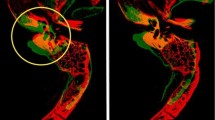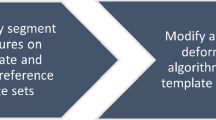Abstract
Purpose
To develop a time-efficient automated segmentation approach that could identify surface structures on the temporal bone for use in surgical simulation software and preoperative surgical training.
Methods
An atlas-based segmentation approach was developed to segment the tegmen, sigmoid sulcus, exterior auditory canal, interior auditory canal, and posterior canal wall in normal temporal bone CT images. This approach was tested in images of 20 cadaver bones (10 left, 10 right). The results of the automated segmentation were compared to manual segmentation using quantitative metrics of similarity, Mahalanobis distance, average Hausdorff distance, and volume similarity.
Results
The Mahalanobis distance was less than 0.232 mm for all structures. The average Hausdorff distance was less than 0.464 mm for all structures except the posterior canal wall and external auditory canal for the right bones. Volume similarity was 0.80 or greater for all structures except the sigmoid sulcus that was 0.75 for both left and right bones. Visually, the segmented structures were accurate and similar to that manually traced by an expert observer.
Conclusions
An atlas-based approach using a deformable registration of a Gaussian-smoothed temporal bone image and refinements using surface landmarks was successful in segmenting surface structures of temporal bone anatomy for use in pre-surgical planning and training.






Similar content being viewed by others
References
Powell KA, Liang T, Hittle B, Stredney D, Kerwin T, Wiet GJ (2017) Atlas-based segmentation of temporal bone anatomy. Int J Comput Assist Radiol Surg 12(11):1937–1944
Klein S, Staring M, Murphy K, Viergever MA, Pluim JPW (2010) Elastix: a toolbox for intensity based medical image registration. IEEE Trans Med Imaging 29:196–205
Shamonin DP, Bron EE, Lelieveldt BPF, Smits M, Klein S, Staring M (2014) Fast parallel image registration on CPU and GPU for diagnostic classification of Alzheimer’s disease. Front Neuroinformatics 7:1–15
Klein S, Staring M (2014) Elastix the manual (http://elastix.isi.uu.nl/)
Liao PS, Chen TS, Chung PC (2001) A fast algorithm for multilevel thresholding. J Inf Sci Eng 17:713–727
Danielsson PE (1980) Euclidean distance mapping. Comput Graph Image Process 14:227–248
https://en.wikipedia.org/wiki/Moore_neighborhood. Accessed 29 Jan 2019
Gonzalez RC, Woods RE (2008) Digital image processing. Pearson Prentice Hall Inc, Englewood Cliffs
Taha AA, Hanbury A (2015) Metrics for evaluating 3D medical image segmentation: analysis, selection, and tool. BMC Med Imaging 15(29):1–28
Kerwin T, Wiet G, Stredney D, Shen HW (2012) Automatic scoring of virtual mastoidectomies using expert examples. Int J Comput Assist Radiol Surg 7(1):1–11
Wiet G, Hittle B, Kerwin T, Stredney D (2012) Translating surgical metrics into automated assessments. Stud Health Technol Inform 173:543–548
Acknowledgements
This research was supported by NIDCD/NIH 1R01-DC011321 and by funding from Nationwide Children’s Hospital, Columbus, OH.
Author information
Authors and Affiliations
Corresponding author
Ethics declarations
Conflict of interest
The authors declare that they have no conflict of interest.
Ethical approval
All procedures performed in this study involving human participants were in accordance with the ethical standards of the Ohio State University Institutional Review Board and have been performed in accordance with the 1964 Helsinki declaration and its later amendments or comparable ethical standards.
Funding
This study was funded by NIDCD/NIH 1R01-DC011321.
Additional information
Publisher’s Note
Springer Nature remains neutral with regard to jurisdictional claims in published maps and institutional affiliations.
Rights and permissions
About this article
Cite this article
Powell, K.A., Kashikar, T., Hittle, B. et al. Atlas-based segmentation of temporal bone surface structures. Int J CARS 14, 1267–1273 (2019). https://doi.org/10.1007/s11548-019-01978-2
Received:
Accepted:
Published:
Issue Date:
DOI: https://doi.org/10.1007/s11548-019-01978-2




